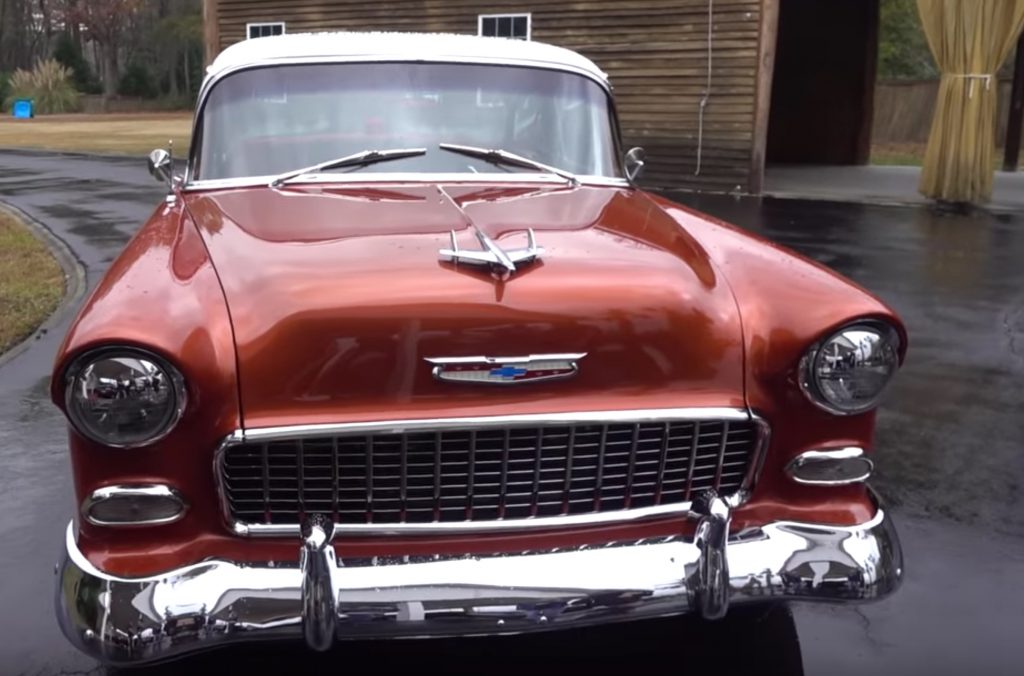

The rear beam axle was fitted with coil springs (the only other minivan besides the Ford Aerostar and Renault Espace at the time). In line with the Chrysler minivans, the Lumina APV was fitted with independent front suspension with MacPherson struts. The Lumina APV has a 109.8 inch wheelbase, sized between the Lumina sedan/coupe and the Astro/Safari. In contrast to the unibody design used by the Astro/Safari and the Van/Vandura, the Lumina APV chassis uses a chassis design similar to the Pontiac Fiero and Saturn SL, with a galvanized steel spaceframe supporting exterior body panels. The Chevrolet Lumina APV is a GM U-body vehicle, using the GMT199 platform designation. For 1994, the model underwent a mid-cycle revision and was renamed the Chevrolet Lumina Minivan (in place of the APV suffix). For 1993, the CL trim was renamed LS the Lumina APV badging was removed from the doors. Base-trim versions featured chrome exterior trim while CL versions were produced with red exterior trim and badging (similar to the Lumina Euro). There was also the Chevrolet APV cargo van, a two-seater commercial vehicle. For the 1989 model year, Chevrolet introduced the Lumina, effectively consolidating the Celebrity and Monte Carlo into a single model line, with the Lumina APV replacing the Celebrity station wagon.Īt its 1990 introduction, the Lumina APV was offered in two trim levels a base trim and an up-level CL trim. The Lumina APV was to compete with the higher-volume Voyager/Caravan directly, serving as a "volume leader", the Trans Sport was to be the minivan equivalent of sporty Pontiac sedans, and the luxury-trim Silhouette was intended as a more contemporary competitor to the Chrysler Town & Country and Ford Aerostar Eddie Bauer.Īt the time of its 1990 release, the Lumina APV was marketed as a bodystyle of the Chevrolet Lumina model line. To expand its market potential (and to mitigate any potential model overlap), GM sought distinct marketing objectives for each model line. Chevrolet would receive a Lumina APV, with Oldsmobile receiving the Silhouette Pontiac adopted the Trans Sport name from the 1986 concept van.ĭuring its development, the APV model lines largely benchmarked the extended-length Chrysler vans, closely matching their length, width, and height (on a shorter wheelbase). In place of the official GMT199 platform designation, GM began to use the APV name, standing for All Purpose Vehicle. In contrast to the Astro/Safari, which used a variety of components from Chevrolet/GMC light trucks, the front-wheel drive GMT199 platform was dedicated to the Chevrolet, Pontiac, and Oldsmobile minivans, sharing primarily engines and transmissions with other GM vehicles. While far more radical in body design, the Trans Sport concept was the first minivan to adopt the front-wheel drive form factor used by the Chrysler minivans. In 1986, GM unveiled the Pontiac Trans Sport concept vehicle, largely serving as a preview of the APV model lines. Sized closely to the short-wheelbase Chevrolet Van, the Astro was marketed in both passenger and cargo van configurations. In response to the first-generation Chrysler minivans, General Motors introduced the rear-wheel drive Chevrolet Astro (and GMC Safari) for the 1985 model year. For 1997, Chevrolet adopted a distinct nameplate for its front-wheel drive minivan, replacing the Lumina APV with the Chevrolet Venture. In terms of size, the Lumina APV was slotted between the Chevrolet Astro and full-size Chevrolet Van.ĭuring its production, the Lumina APV and its Pontiac and Oldsmobile counterparts were assembled at the North Tarrytown Assembly facility, becoming the final vehicles produced there prior to its closure. Though manufactured on a model-specific chassis, the Lumina APV was front-wheel drive, deriving its powertrain from GM sedans. Introduced a year before the second-generation Chrysler minivans, the Lumina APV was the first American-market minivan to adopt the form factor of the Dodge Caravan and Plymouth Voyager. Marketed alongside the Pontiac Trans Sport and Oldsmobile Silhouette, the Lumina APV competed against the Dodge Grand Caravan/Plymouth Grand Voyager, the extended-length Ford Aerostar, and the Mazda MPV. The first front-wheel drive minivan sold by Chevrolet, the Lumina APV was sold in a single generation from the 1990 to 1996 model years. The Chevrolet Lumina APV is a minivan that was produced by the Chevrolet division of General Motors. Transverse front-engine, front-wheel drive


 0 kommentar(er)
0 kommentar(er)
